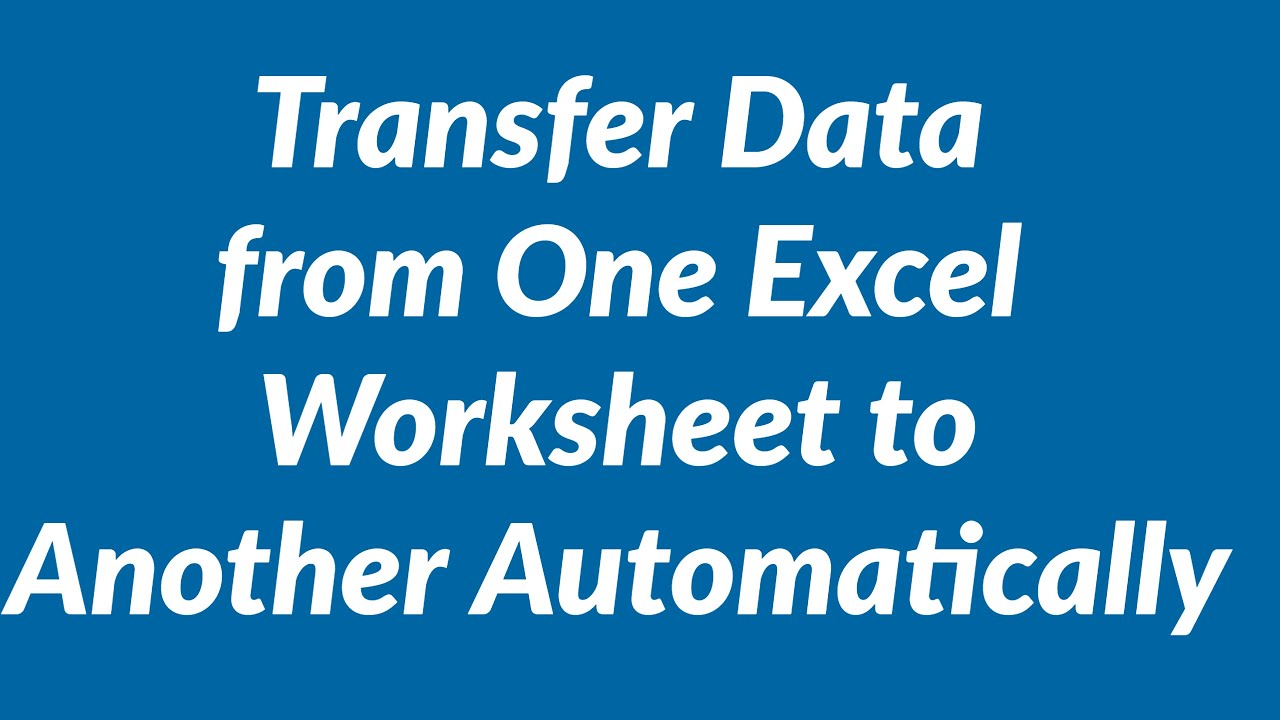5 Ways to Display Data from Another Excel Sheet

Exploring the Basics of Excel Sheet References

Before we delve into the methods of displaying data from another Excel sheet, let's lay the groundwork by understanding the basics. Excel offers various ways to reference data across different sheets, which can be incredibly useful for managing large datasets or creating comprehensive reports. The key here is understanding cell references and sheet names.
- Cell References: In Excel, you reference cells by their address, like A1 or B2.
- Sheet Names: Sheets within an Excel workbook can have unique names, making it easier to navigate and reference data across different sheets.
1. Using Cell References to Link Sheets

One of the simplest and most direct methods to display data from another Excel sheet is by using cell references. Here’s how:
- Select the Cell: Choose the cell where you want the data to appear on your current sheet.
- Enter Reference: Type an equal sign (=) followed by the sheet name and an exclamation point (!), then the cell reference. For example, if you want to reference cell A1 from Sheet2, you would type
=Sheet2!A1in the formula bar. - Copy and Paste: You can also copy the cell from the source sheet and paste it with a link into your destination sheet. Excel will automatically create a reference to the original cell.
📝 Note: Ensure sheet names don't contain spaces or special characters that might interfere with Excel formulas.
2. Utilizing Excel Formulas for Data Display

Excel’s formula capabilities extend far beyond simple cell references. Here are a few ways to harness Excel formulas for data display:
- INDIRECT Function: This function allows you to create dynamic references that change based on variables. For instance,
=INDIRECT("'" & B1 & "'!A1")where B1 contains the sheet name. - SUMIF/AVERAGEIF Functions: These can pull data from another sheet based on specific criteria. For example,
=SUMIF(Sheet2!A1:A10, ">10", Sheet2!B1:B10).
These formulas can become quite powerful when you need to aggregate or analyze data from different sheets simultaneously.
3. Data Consolidation and Consolidation Sheets

When dealing with multiple sheets that contain similar data or need to be combined, Excel’s Data Consolidation feature can be very useful:
- Go to the Data tab and select Consolidate.
- Choose the Function to summarize the data (Sum, Count, etc.).
- Add references from multiple sheets by clicking in the Reference box and selecting ranges from each sheet. Make sure to check Top row or Left column if your data includes headers or labels.
Excel will combine the selected data into a summary on a new sheet, dynamically linked to the source sheets.
4. 3D References for Working with Multiple Sheets

Excel allows you to create 3D references to work with data across multiple sheets in a structured manner:
- Formula Syntax: The formula for a 3D reference is
=SUM(Sheet1:Sheet3!A1:A10). This sums up the values in cell A1 through A10 from Sheet1 through Sheet3. - Application: 3D references are excellent for creating summary sheets that pull data from various tabs in a workbook without manually entering each sheet name.
Here's a small example of how a summary table could look:
| Category | Sheet1 Total | Sheet2 Total | Sheet3 Total | Grand Total |
|---|---|---|---|---|
| Product A | =Sheet1!B2 | =Sheet2!B2 | =Sheet3!B2 | =SUM(Sheet1:Sheet3!B2) |
| Product B | =Sheet1!C2 | =Sheet2!C2 | =Sheet3!C2 | =SUM(Sheet1:Sheet3!C2) |

📝 Note: When using 3D references, keep in mind that they will only work if the sheets are in sequential order.
5. Using VLOOKUP and HLOOKUP for Data Retrieval

When you need to retrieve specific data from another sheet based on a lookup value, VLOOKUP and HLOOKUP functions come in handy:
- VLOOKUP Syntax:
=VLOOKUP(lookup_value, table_array, col_index_num, [range_lookup]). - HLOOKUP Syntax:
=HLOOKUP(lookup_value, table_array, row_index_num, [range_lookup]).
To use these functions effectively:
- Set your table_array to include the sheet name, like
Sheet2!A1:E10. - Ensure your data is structured appropriately for VLOOKUP (vertical) or HLOOKUP (horizontal).
- Be cautious with range_lookup; setting it to TRUE will approximate matches, while FALSE demands an exact match.
In conclusion, knowing how to display data from another Excel sheet can transform your data management and analysis tasks, making them more efficient and insightful. Whether you're consolidating data, creating dynamic reports, or simply linking information, Excel provides a variety of tools to handle these tasks seamlessly. Utilize cell references, formulas, data consolidation, 3D references, and lookup functions to navigate and organize your data across multiple sheets with ease.
How do I reference a cell from another sheet in Excel?

+
To reference a cell from another sheet, type an equal sign (=) followed by the sheet name, an exclamation mark (!), and the cell address. For example, =Sheet2!A1 will reference cell A1 from Sheet2.
What is the benefit of using the INDIRECT function?

+
The INDIRECT function allows for dynamic cell references, which means you can change what data you’re pulling by simply changing the sheet name in a cell rather than the formula itself.
Can I use 3D references for charts or pivot tables?

+
No, 3D references cannot be used directly in charts or pivot tables. They are primarily for formula calculations across multiple sheets.